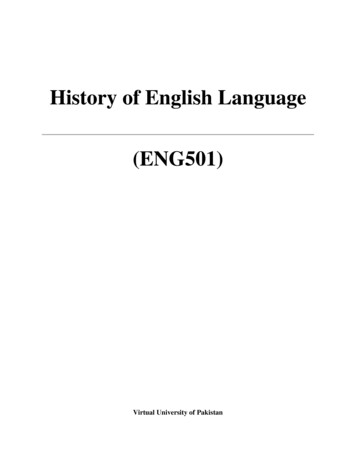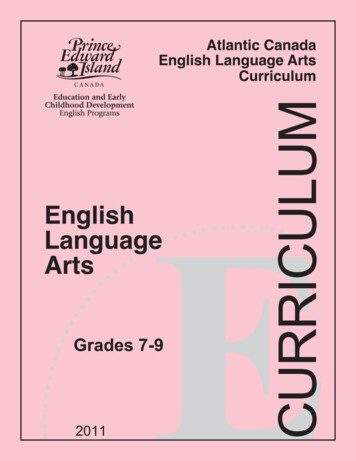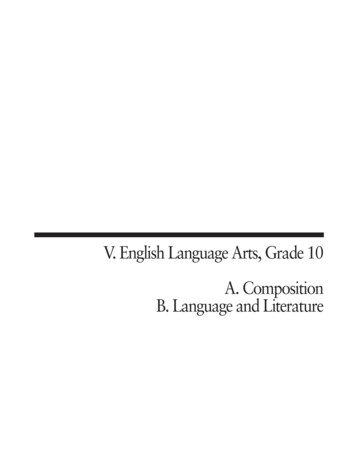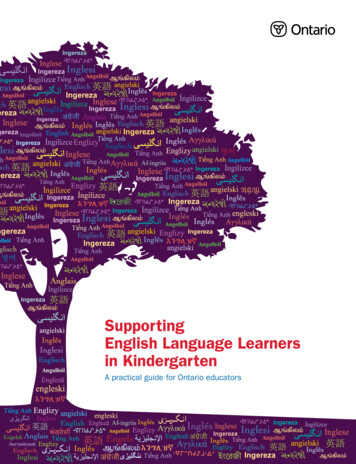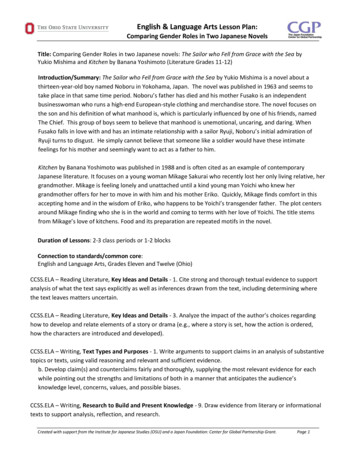
Transcription
English & Language Arts Lesson Plan:Comparing Gender Roles in Two Japanese NovelsTitle: Comparing Gender Roles in two Japanese novels: The Sailor who Fell from Grace with the Sea byYukio Mishima and Kitchen by Banana Yoshimoto (Literature Grades 11-12)Introduction/Summary: The Sailor who Fell from Grace with the Sea by Yukio Mishima is a novel about athirteen-year-old boy named Noboru in Yokohama, Japan. The novel was published in 1963 and seems totake place in that same time period. Noboru’s father has died and his mother Fusako is an independentbusinesswoman who runs a high-end European-style clothing and merchandise store. The novel focuses onthe son and his definition of what manhood is, which is particularly influenced by one of his friends, namedThe Chief. This group of boys seem to believe that manhood is unemotional, uncaring, and daring. WhenFusako falls in love with and has an intimate relationship with a sailor Ryuji, Noboru’s initial admiration ofRyuji turns to disgust. He simply cannot believe that someone like a soldier would have these intimatefeelings for his mother and seemingly want to act as a father to him.Kitchen by Banana Yoshimoto was published in 1988 and is often cited as an example of contemporaryJapanese literature. It focuses on a young woman Mikage Sakurai who recently lost her only living relative, hergrandmother. Mikage is feeling lonely and unattached until a kind young man Yoichi who knew hergrandmother offers for her to move in with him and his mother Eriko. Quickly, Mikage finds comfort in thisaccepting home and in the wisdom of Eriko, who happens to be Yoichi’s transgender father. The plot centersaround Mikage finding who she is in the world and coming to terms with her love of Yoichi. The title stemsfrom Mikage’s love of kitchens. Food and its preparation are repeated motifs in the novel.Duration of Lessons: 2-3 class periods or 1-2 blocksConnection to standards/common core:English and Language Arts, Grades Eleven and Twelve (Ohio)CCSS.ELA – Reading Literature, Key Ideas and Details - 1. Cite strong and thorough textual evidence to supportanalysis of what the text says explicitly as well as inferences drawn from the text, including determining wherethe text leaves matters uncertain.CCSS.ELA – Reading Literature, Key Ideas and Details - 3. Analyze the impact of the author’s choices regardinghow to develop and relate elements of a story or drama (e.g., where a story is set, how the action is ordered,how the characters are introduced and developed).CCSS.ELA – Writing, Text Types and Purposes - 1. Write arguments to support claims in an analysis of substantivetopics or texts, using valid reasoning and relevant and sufficient evidence.b. Develop claim(s) and counterclaims fairly and thoroughly, supplying the most relevant evidence for eachwhile pointing out the strengths and limitations of both in a manner that anticipates the audience’sknowledge level, concerns, values, and possible biases.CCSS.ELA – Writing, Research to Build and Present Knowledge - 9. Draw evidence from literary or informationaltexts to support analysis, reflection, and research.Created with support from the Institute for Japanese Studies (OSU) and a Japan Foundation: Center for Global Partnership Grant.Page 1
English & Language Arts Lesson Plan:Comparing Gender Roles in Two Japanese NovelsGuiding questions/essential questions: How do the depictions of the gender roles compare in these twonovels? What literary elements lead to these differences?Learning Objectives: Student will compare the depiction of gender roles present in the two novels andanalyze the impacts on each.Materials:a) Copies of the text being studied--this lesson must be completed AFTER students have read thenovels.b) Copies of the note-taking sheetPre-Assessment: Informal questioning: Begin by asking students to identify commonly held beliefs aboutgender roles in their cultures. What is manly? What is womanly? Depending on the cultures present in yourclassroom, this could offer a range of answers. You may even want students to journal on these topics forhomework the night before, share briefly in class with one another, and then have a limited discussion as awhole class.Lesson Activity:1. Begin by asking the students to make some generalities about the roles of men and women in bothnovels. How do these generalities compare to our own culture? Are men typically assertive whereaswomen ‘should’ be passive?2. Pass out the comparison note pages to the students. Students could work in pairs or small groups tocomplete the analysis. Depending on time or the class, you could also jigsaw the chart to allow thestudents to focus more deeply on their group’s specific character or just one side for each gender orjust one.3. Regardless of how the teacher divides the task, students should summarize instances that fall underthat specific heading. Be sure students pull quotations to support their assertions for each. Pullingquotations from the text for support will insure that these are text-based responses and not simplystudent opinion.4. Once students have pulled evidence for the characters, they should think about the ‘point ofanalysis’ at the bottom of the page. What comparisons can be made among these men and women?5. Ask students to consider the following questions: What leads to these different depictions ofcharacter? Does setting & publication have anything to do with the differences? How do theauthors’ depictions of gender impact the tone or mood of the novels?Post Assessment: Students will complete a comparison essay on a specific character or a specific gender.Extending the lesson: Truly, these two novels offer quite a bit of rich comparison. You could have studentsalso compare the depiction of fathers in the novels, as Ryuji attempts to father Noboru to fatal ends and Erikochooses to become a mother to Yoichi after his wife dies. Both novels also have existential themes at work.Created with support from the Institute for Japanese Studies (OSU) and a Japan Foundation: Center for Global Partnership Grant.Page 2
English & Language Arts Lesson Plan:Comparing Gender Roles in Two Japanese NovelsSources:Kellerman, Robert. “A Room of Her Own in Banana Yoshimoto’s Kitchen.” Pacific Asia Inquiry Volume 1,Number 1. University of Guam. 2010. Web. 21 February 2016.Mishima, Yukio. The Sailor who Fell from Grace with the Sea. Trans. John Nathan. New York, Vintage, 1994.Print.Yoshimoto, Banana. Kitchen. Trans. Megan Backus. New York: Grove Press, 1993. Print.Lesson plan written by: Jamie Foley, chair, English Department, Columbus Alternative High School,Columbus, OhioCreated with support from the Institute for Japanese Studies (OSU) and a Japan Foundation: Center for Global Partnership Grant.Page 3
Traditional Masculine QualitiesExhibiting/Commenting on Traditional QualitiesNoboruRyujiThe ChiefYoichiEriko as a manPoint of analysis:Quotation for Support
Non-Traditional Masculine TraitsExhibiting/Commenting on Non-Traditional QualitiesNoboruRyujiThe ChiefYoichiEriko as a manPoint of analysis:Quotation for Support
Traditional Female Behavior/TraitsExhibiting/Commenting on Traditional QualitiesFusakoMikageEriko as a womanPoint of analysis:Quotation for Support
Non-Traditional Female Behavior/TraitsExhibiting/Commenting on Non-Traditional QualitiesFusakoMikageEriko as a womanPoint of analysis:Quotation for Support
Comparing Gender Roles in Two Japanese Novels Created with support from the Institute for Japanese Studies (OSU) and a Japan Foundation: Center for Global Partnership Grant. Page 1 Title: Comparing Gender Roles in two Japanese novels: The Sailor who Fell from Grace with the Sea by Yukio Mishima and Kitchen by Banana Yoshimoto (Literature Grades 11-12) Introduction/Summary: The Sailor who Fell .



